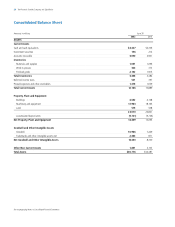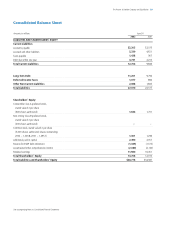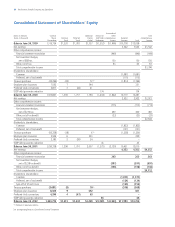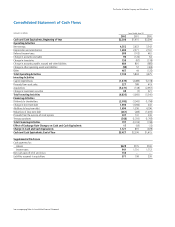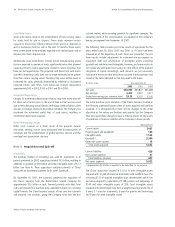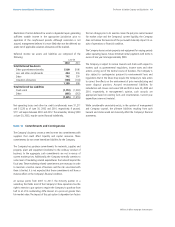Proctor and Gamble 2002 Annual Report Download - page 36
Download and view the complete annual report
Please find page 36 of the 2002 Proctor and Gamble annual report below. You can navigate through the pages in the report by either clicking on the pages listed below, or by using the keyword search tool below to find specific information within the annual report.
34 The Procter & Gamble Company and Subsidiaries
Asset Write-Downs
Asset write-downs relate to the establishment of new carrying values
for assets held for sale or disposal. These assets represent excess
capacity in the process of being removed from service or disposed as
well as businesses held for sale in the next 12 months. These assets
were written down to the amounts expected to be realized upon sale or
disposal, less minor disposal costs.
Additionally, asset write-downs include certain manufacturing assets
that are expected to operate at levels significantly below their planned
capacity, primarily capital expansions related to recent initiatives that
have not met expectations. The projected cash flows from such assets
over their remaining useful lives are no longer estimated to be greater
than their current carrying values; therefore, they were written down to
estimated fair value, generally determined by reference to discounted
expected future cash flows. Such before-tax charges represented
approximately $45 in 2002, $160 in 2001 and $0 in 2000.
Accelerated Depreciation
Charges for accelerated depreciation relate to long-lived assets that will
be taken out of service prior to the end of their normal service period
due to manufacturing consolidations, technology standardization, plant
closures or strategic choices to discontinue initiatives. The Company has
shortened the estimated useful lives of such assets, resulting in
incremental depreciation expense.
Other Restructuring Charges
Other costs incurred as a direct result of the program include
relocation, training, certain costs associated with discontinuation of
initiatives and the establishment of global business services and the
new legal and organization structure.
Note 3 Acquisitions and Spin-off
Acquisitions
The purchase method of accounting was used for acquisitions in all
periods presented. In 2002, acquisitions totaled $5.5 billion, resulting in
additions to goodwill of $3.6 billion and other intangible assets of $1.7
billion (see Note 4). These acquisitions consisted primarily of Clairol
along with an incremental payment for Dr. John’s Spinbrush.
On November 16, 2001, the Company completed the acquisition of
the Clairol business from the Bristol-Myers Squibb Company for
approximately $5.0 billion in cash, financed primarily with debt. Total
cash paid includes final purchase price adjustments based on a working
capital formula. The Clairol business consists of hair care, hair colorants
and personal care products, giving the Company entry into the hair
colorant market, while providing potential for significant synergies. The
operating results of the Clairol business are reported in the Company’s
beauty care segment from November 16, 2001.
The following table provides pro forma results of operations for the
years ended June 30, 2002, 2001 and 2000, as if Clairol had been
acquired as of the beginning of each fiscal year presented. The pro
forma results include adjustments for estimated interest expense on
acquisition debt and amortization of intangible assets, excluding
goodwill and indefinite-lived intangibles. However, pro forma results do
not include any anticipated cost savings or other effects of the planned
integration of Clairol. Accordingly, such amounts are not necessarily
indicative of the results that would have occurred if the acquisition had
closed on the dates indicated, or that may result in the future.
The initial purchase price allocation of the Clairol business resulted in
the following condensed balance sheet of assets acquired and liabilities
assumed. It is anticipated that there will be changes to the initial
allocation as fair values are finalized next quarter, but the Company
does not expect these changes to have a material impact on the results
of operations or financial condition of the Company in future periods.
The Clairol acquisition resulted in $1,533 in total intangible assets
acquired with $1,220 allocated to trademarks with indefinite lives. The
remaining $313 of acquired intangibles have determinable useful lives
and were assigned to trademarks of $128, patents and technology of
$146 and other intangible assets of $39. Total intangible assets
acquired with determinable lives have a weighted average useful life of
9 years (11 years for trademarks, 9 years for patents and technology
and 5 years for other intangible assets).
Notes to Consolidated Financial Statements
Millions of dollars except per share amounts
$40,801
2,927
$2.07
$41,488
3,517
$2.45
$40,780
4,406
$3.13
2002
Net sales
Net earnings
Diluted net earnings per common share
Years Ended June 30
Pro forma results
2000
2001
$487
184
1,533
3,300
18
5,522
450
47
497
5,025
Current assets
Property, plant and equipment
Intangible assets
Goodwill (1)
Other non-current assets
Total assets acquired
Current liabilities
Non-current liabilities
Total liabilities assumed
Net assets acquired
(1) Approximately $2.6 billion is expected to be deductible for tax purposes.
Opening Balance






